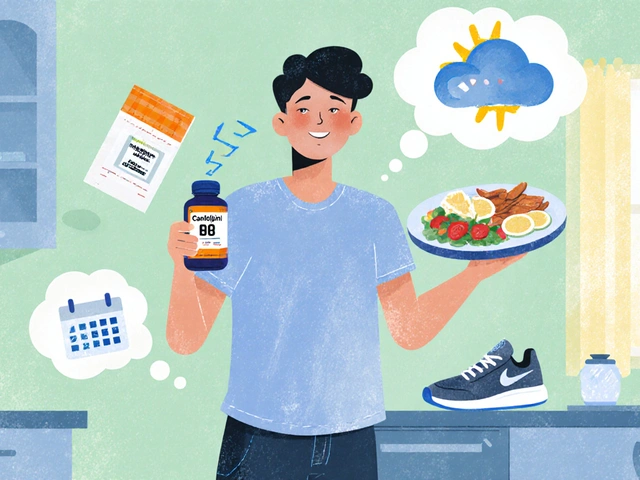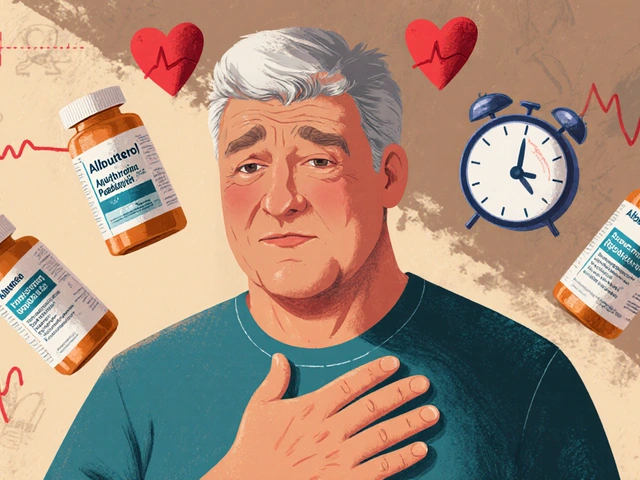You searched for Amoxil because you want fast, trustworthy answers-what it is, whether it’s right for your infection, how to take it safely, and how to get it legally in the UK today. You’ll get direct paths to the official leaflet and NHS guidance, no filler. Expect straight talk on what Amoxil treats (and what it doesn’t), side effects to watch for, and the safest way to sort a prescription-online or via your GP.
Find the right page fast: official info, safe prescribing, and how to get it in the UK
Short on time? Start here. The steps below get you to trusted, UK-specific information and the safest route to a prescription if you need one.
Amoxil is the brand name for amoxicillin, a penicillin antibiotic. In the UK, generic “amoxicillin” is usually dispensed even if your script says “Amoxil”. That’s normal and clinically equivalent.
To reach the official product information (the patient leaflet and prescriber details) without clicking around:
- Open your preferred search engine.
- Type: “MHRA SmPC Amoxil” for the prescriber document, or “MHRA PIL amoxicillin” for the patient leaflet. Look for results from the Medicines and Healthcare products Regulatory Agency (MHRA).
- On the product page, choose the latest “Patient Information Leaflet (PIL)” for how to take it and common side effects. The “SmPC” is the technical prescriber document.
For plain-English advice and whether it’s suitable for your condition:
- Search: “NHS amoxicillin” and click the NHS Medicines A-Z page.
- Use the sections on uses, how to take, side effects, pregnancy/breastfeeding, and interactions.
Need a prescription today?
- Contact your GP practice or NHS 111 if you’re unsure it’s needed. Many infections are viral and settle without antibiotics. NICE antimicrobial guidance backs targeted use only when signs point to bacterial infection.
- For dental infections, ring your NHS or private dentist; they are the appropriate prescribers for dental abscesses.
- To use a UK-regulated online pharmacy or online doctor: search “GPhC registered online pharmacy” and choose a provider displaying a valid UK registration (General Pharmaceutical Council). You’ll complete a health questionnaire; a UK prescriber will review before issuing any script.
- Expect same-day or next-day dispatch once approved. Brands vary; you’ll likely receive generic amoxicillin. That’s okay.
Quick safety check before you chase a script:
- Penicillin allergy history? Stop and speak to a clinician first.
- On warfarin, methotrexate, or probenecid? You’ll need tailored advice and possibly monitoring.
- Bad sore throat with a rash after taking amoxicillin previously? That can happen with glandular fever (EBV); tell your clinician.
What Amoxil is, what it treats, and where it won’t help
Amoxil contains amoxicillin, a beta-lactam antibiotic (a penicillin). It kills certain bacteria by preventing their cell walls from forming properly. It doesn’t touch viruses, so it won’t help with colds, flu, most sore throats, or RSV.
Common UK uses (prescriber decides based on your symptoms, exam, and risk):
- Ear, nose, and throat infections likely caused by bacteria (e.g., otitis media, sinusitis) when severity or duration suggests benefit. NICE guidance supports watchful waiting for many mild cases.
- Some chest infections, including community-acquired pneumonia, when bacteria are suspected.
- Urinary infections only in certain scenarios; resistance patterns mean other antibiotics are often first choice.
- Dental infections (with drainage if needed). Dentists commonly prescribe amoxicillin or metronidazole depending on the case.
- Skin infections when appropriate, or as part of combination therapy for specific conditions (e.g., H. pylori eradication).
Situations where amoxicillin is not helpful or not first-line:
- Viral illnesses: colds, most sore throats, uncomplicated acute coughs.
- Known or suspected atypical pneumonia (often needs a different antibiotic).
- Uncomplicated cystitis in otherwise healthy women (trimethoprim or nitrofurantoin are typical first-line, depending on local resistance and patient factors).
How quickly you should feel better: usually within 24-48 hours if the bacteria are susceptible and the diagnosis is right. If you’re the same or worse at 48 hours, contact your prescriber. Don’t add leftover antibiotics or double up with a friend’s tablets-that muddies the picture and can delay the right treatment.
Antibiotic stewardship matters. Using amoxicillin when it won’t help adds side effects without benefit and fuels resistance. NHS and NICE guidance support “no antibiotics” or delayed prescriptions for many mild, self-limiting infections. If your clinician says you can wait, they’re not fobbing you off-they’re protecting you from needless risks.

Safe use: dosing basics, side effects, interactions, and special cases
Always follow the exact instructions on your label. Doses vary by infection, age, kidney function, and severity. Your pharmacist will check for interactions and give the correct measuring device for liquid medicines.
How it’s taken:
- Capsules/tablets: usually two or three times a day, spaced evenly (e.g., morning-midday-evening if three times daily).
- Liquid (oral suspension): shake well each time; use the oral syringe or spoon provided-no kitchen teaspoons.
- With or without food: you can take it with a snack if it upsets your stomach.
Missed a dose? Take it as soon as you remember unless it’s nearly time for the next one. Don’t double up. Finish the course as prescribed unless your prescriber tells you to stop early.
Common side effects (usually mild and short-lived):
- Upset stomach, nausea, loose stools.
- Skin rash (see below for when to worry).
- Oral or vaginal thrush, especially with longer courses.
Serious but uncommon reactions-seek urgent help if you notice:
- Allergic reaction signs: wheeze, chest tightness, swelling of lips/face, hives, or severe dizziness.
- Widespread, blistering rash; mouth/eye sores; peeling skin.
- Severe, persistent diarrhoea with tummy pain or blood (risk of C. difficile).
- Yellowing of the skin/eyes with dark urine (liver issues).
Allergy vs non-allergic rash: a flat, blotchy pink rash can appear when amoxicillin is taken during glandular fever; it’s not the same as a penicillin allergy. Hives (raised, itchy welts) or any breathing/swelling symptoms are different and need urgent assessment. If in doubt, stop the medicine and call for advice.
Interactions worth checking:
- Warfarin: amoxicillin can increase INR-monitoring and dose adjustments may be needed.
- Methotrexate: higher risk of methotrexate toxicity-dose review or alternative antibiotic may be required.
- Probenecid: can raise amoxicillin levels-usually avoided.
- Allopurinol with amoxicillin: higher chance of rash.
- Oral contraceptive pills: amoxicillin doesn’t reduce pill efficacy by itself, but vomiting/diarrhoea can. If you’re sick or have severe diarrhoea for more than 24 hours, use condoms and follow your pill’s “missed pill” guidance.
Alcohol? Moderate drinking isn’t contraindicated, but alcohol can worsen stomach upset and dehydration. Rest and fluids help you recover faster.
Pregnancy and breastfeeding: amoxicillin is generally considered safe. It passes into breast milk in tiny amounts; a baby may have mild tummy upset or thrush-usually manageable. Always tell your clinician you’re pregnant or breastfeeding so they can weigh benefits and risks for your specific case.
Kidney problems: prescribers may adjust the dose if your kidneys don’t clear medicines well. Older adults and people living with chronic kidney disease should have dosing checked against the BNF.
Storage tips:
- Tablets/capsules: keep in a cool, dry place away from heat and moisture.
- Liquid: check the label. Many UK amoxicillin suspensions need refrigeration after mixing and must be discarded after 7-14 days. Your pharmacist will mark this on the bottle.
Simple self-check before each dose:
- Is this your name and the right strength on the label?
- Is it still within expiry (and within the discard window for liquids)?
- Any new medicines started this week that could interact? If yes, ask your pharmacist.
| At-a-glance facts (UK, 2025) | Details |
|---|---|
| Active ingredient | Amoxicillin (a penicillin antibiotic) |
| Prescription status | Prescription-only medicine (POM) in the UK |
| Common forms | 250 mg/500 mg capsules or tablets; oral suspension (various strengths) |
| Typical frequency | 2-3 times daily, depending on indication |
| Onset of improvement | Often within 24-48 hours if bacteria are susceptible |
| Driving/operating machinery | No specific restrictions unless you feel unwell or dizzy |
| Pregnancy/breastfeeding | Generally compatible; confirm with your prescriber |
| Known cautions | Penicillin allergy, renal impairment, interactions (warfarin, methotrexate) |
| Common side effects | GI upset, rash, thrush |
| Serious reactions-seek urgent help | Allergic reaction, severe skin reactions, severe diarrhoea (C. diff), jaundice |
| Source documents | NHS Medicines A-Z; MHRA SmPC/PIL; BNF; NICE antimicrobial guidance |
Quick decision helper (not a diagnosis):
- You have a cold, sore throat, or cough under a week with improving symptoms: self-care, fluids, rest; usually no antibiotic.
- You have ear or sinus pain for over 10 days, or high fever, or you’re at higher risk (frail, long-term conditions): ring your GP; they’ll decide if amoxicillin is suitable.
- Teeth pain with swelling or bad taste: contact a dentist-drainage plus an antibiotic if needed.
- You started amoxicillin and feel no better or worse at 48 hours: contact your prescriber; don’t take leftover antibiotics.
Pro tips to feel better while your body heals:
- Take doses evenly spaced; set phone reminders.
- If your stomach is sensitive, pair with a light snack.
- Separate probiotics or live yoghurt by 2-3 hours from your dose if you choose to use them.
- Hydrate; it helps symptoms and supports recovery.
FAQs, next steps, and troubleshooting
Quick answers to the most common follow-ups people have once they land on an Amoxil page.
Is Amoxil the same as amoxicillin?
Yes. Amoxil is a brand name for amoxicillin. In the UK, pharmacies commonly dispense generic amoxicillin, which has the same active ingredient and clinical effect.
How long should I take it?
That depends on the infection and your prescriber’s plan. Courses are often 3-7 days. Follow the exact label. If you feel worse, contact your prescriber rather than stopping abruptly.
Can I drink alcohol with it?
Moderate alcohol isn’t banned, but it can make you feel more tired and queasy. If you’re unwell, skip alcohol until you’re recovering.
Will it affect my contraceptive pill?
Not directly. The bigger issue is vomiting or severe diarrhoea, which can reduce pill absorption. If that happens, follow your pill’s “missed pill” rules and use condoms for backup.
What if I’m allergic to penicillin?
Do not take amoxicillin if you have a true penicillin allergy. Tell your clinician what happened, how soon after the dose it started, and what symptoms you had. They can pick an alternative if needed.
Can my child take it?
Yes, when prescribed. Children’s doses are weight-based. Use the oral syringe, not kitchen spoons. Some liquid forms need refrigeration and have a strict discard date-read the label.
What if I miss a dose?
Take it when you remember unless it’s nearly time for the next one. Don’t take two at once. Keep going as directed.
I have diarrhoea after starting-what now?
Mild loose stools are common. Keep hydrated. If you have severe diarrhoea, tummy cramps, blood/mucus, or a fever, seek medical advice-rarely, antibiotics can trigger C. difficile.
Can I take it with ibuprofen or paracetamol?
Yes, for pain or fever, unless you’ve been told not to use those medicines. If you have kidney issues, check before using ibuprofen.
What if my pharmacy says “Amoxil is out of stock”?
They will usually supply generic amoxicillin instead. If the exact strength or form is unavailable, they can contact your prescriber to adjust. UK supply has been more stable lately, but children’s liquids can still fluctuate.
How do I avoid thrush while on antibiotics?
Keep the mouth clean, consider live yoghurt or probiotics spaced away from the dose (evidence is mixed, but many people find it helps), and call if symptoms suggest thrush. It’s treatable.
Does it stain teeth?
Liquid amoxicillin can sometimes cause mild surface staining in children; good brushing and dental check-ups help. It’s cosmetic and typically temporary.
When should I seek urgent care?
- Breathing difficulty, swelling of face/lips, or widespread hives after a dose.
- Severe rash with blisters or peeling skin.
- Severe, persistent diarrhoea with abdominal pain or fever.
- Confusion, severe drowsiness, or signs of dehydration in vulnerable people.
What’s the legal way to get Amoxil in the UK?
- Through your GP, dentist (for dental infections), urgent care when indicated, or a UK-registered online prescriber after a proper assessment.
- It is not legally sold without a prescription. Avoid unverified websites-counterfeit antibiotics are a real risk.
- In England, standard NHS prescription charges apply unless you’re exempt; in Scotland, Wales, and Northern Ireland, NHS prescriptions are free.
Troubleshooting by scenario:
- Day 2 and no change: contact your prescriber; they may review dose, duration, or diagnosis.
- Severe stomach upset: take with food, smaller snacks, and plenty of fluids. If symptoms are intense or persistent, call for advice.
- Rash after dose: stop and seek advice. If it’s hives or you’re wheezy/short of breath, call emergency services.
- Can’t swallow capsules: ask your pharmacist about a liquid form or whether capsules can be opened (depends on product).
- Traveling: keep tablets in original packaging; for liquids, check storage rules-refrigeration may be needed. Ask your pharmacist if a tablet form is suitable instead.
Checklists you can screenshot:
Before starting
- Confirm no penicillin allergy.
- List your meds: warfarin, methotrexate, probenecid, allopurinol, contraceptive pill.
- Confirm dose, frequency, and duration on your label.
- Ask if your child’s liquid needs the fridge and the discard date.
While taking it
- Set reminders for even spacing.
- Watch for side effects and hydration status.
- If no improvement by 48 hours, call your prescriber.
When you finish
- Don’t keep leftovers-return to the pharmacy for disposal.
- If symptoms recur, don’t self-start; you may need a different approach or tests.
Where this guidance comes from: NHS Medicines A-Z for amoxicillin, the BNF (British National Formulary) for dosing and interactions, MHRA SmPC and PIL for product specifics, and NICE antimicrobial prescribing guidelines for when antibiotics help. If your situation is unusual, those sources will be the basis for your clinician’s tailored plan.







7 Comments
Vani Prasanth August 22, 2025
If you’re unsure about amoxicillin, start by checking your allergy history – a simple question for your GP can save a lot of trouble. Make sure you’ve listed any penicillin reactions on your medical record, even if they were mild. It’s also worth confirming any current medicines that might interact, like warfarin or methotrexate, before you pick up the script. Staying hydrated and taking the dose with a light snack can reduce stomach upset, which many people find helpful. Finally, keep the medication in a cool, dry place and discard any unused liquid after the labelled period.
Maggie Hewitt September 3, 2025
Oh great, another guide that tells you to actually talk to a doctor.
Mike Brindisi September 14, 2025
Amoxicillin works by stopping bacterial cell walls from forming so it’s only useful against bacteria not viruses. If you have a cold or flu you’ll just be feeding resistance instead of getting better. The dosing schedule is usually twice or three times a day and you must finish the whole pack even if you feel fine. Skipping doses or stopping early lets the surviving bugs become tougher. For people on warfarin keep an eye on INR because amox can raise it. Those on methotrexate may need a dose adjustment to avoid toxicity. And don’t forget the drug can reduce the effectiveness of oral contraceptives if you’re vomiting or have severe diarrhoea.
Steven Waller September 26, 2025
Think of the prescription as a partnership between you and your clinician, where clear communication guides the safest use. When you understand why a particular antibiotic is chosen, adherence improves and outcomes are better. Remember that antibiotics are a shared resource; overuse harms everyone by fostering resistance. If side effects arise, report them promptly so adjustments can be made without delay.
Puspendra Dubey October 9, 2025
Listen, when you pop that Amoxil it’s not just a pill, it’s a tiny epic saga of chemistry and human drama. The moment it meets the bacterial fortress, a battle commences, and you, dear patient, are the silent spectator to microscopic war. Yet many forget the simple truth: a tiny rash can herald a grand betrayal, especially if you’ve danced with glandular fever before. You might feel a gentle itch, but ignore it and you risk a full‑blown anaphylactic opera – imagine the curtains falling on your own breathing. And, oh, the stomach! It may protest with cramping, because the gut’s flora gets an unexpected guest at the party. Some claim probiotics are the peacemakers, but the science whispers a more cautious lullaby – take them at least two hours apart, lest they clash. The liquid form, that sweet amber syrup, can stain those tiny baby teeth, a cosmetic tragedy that only a diligent brushing can mend. Remember the fridge rule: once mixed, the potion must chill, and after two weeks it expires like a forgotten love letter. If you’re on warfarin, the blood’s clotting script can rewrite itself, nudging the INR into dangerous territories. Methotrexate users, beware – the combination can summon toxicity like a cursed spell from an ancient grimoire. And for the brave souls on birth control, the real villain is not the antibiotic but the vomiting that steals absorption, leaving you vulnerable. Should you ever feel a sudden swelling of lips or a hissing breath, call emergency – it’s not drama, it’s a life‑saving act. So respect the guidelines, cherish the pharmacy’s counsel, and treat Amoxil not as a miracle cure but as a carefully measured ally in the grand quest for health 😊.
Shaquel Jackson November 1, 2025
I guess the guide covers everything, but honestly it feels a bit overkill for a simple antibiotic. Maybe just a quick reminder about allergies would've sufficed. Anyway, thanks for the effort 😐
Tom Bon December 6, 2025
The information presented aligns well with NHS recommendations and offers a thorough overview of amoxicillin usage. It emphasizes prudent prescribing, which is essential for antimicrobial stewardship. The dosage and safety sections are clearly delineated for both adults and children. Additionally, the guide outlines the legal avenues for obtaining a prescription in the UK. Overall, it serves as a reliable reference for patients seeking clarity on this medication.